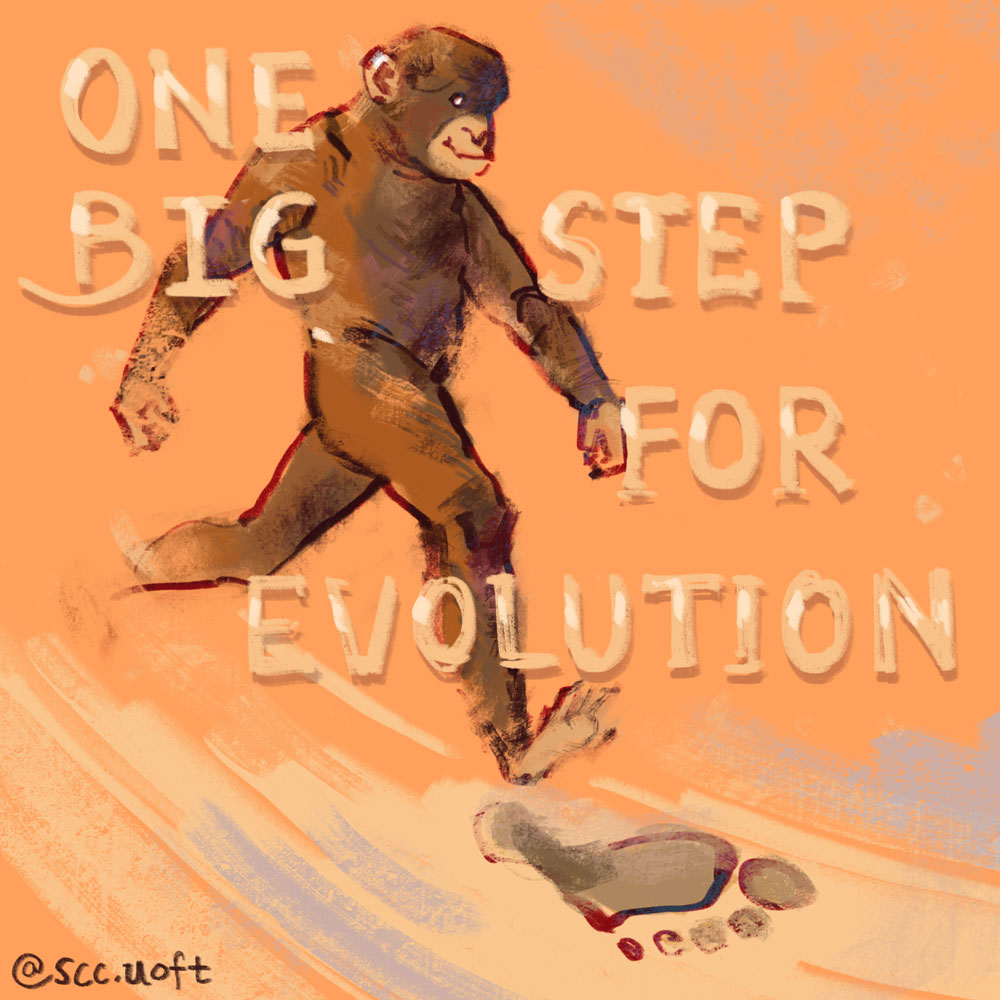
Written by Hayley McKay
Illustrated by Amy Zhang
What makes humans different from our great ape relatives? Many people would say the evolution of larger brains was the key for humans to develop into the creatures we are today. While true, this is not the only important aspect for our development. Bipedalism, or the ability to walk on two feet, is also a key feature differentiating us from great apes.
The evolution of bipedalism has been a topic of great debate among anthropologists for years, with varying theories about how, where and when this trait emerged. Until recently, the oldest evidence of our ancestors walking upright dates back to 6 million years ago (mya), based on thigh bones from an ape species called Orrorin tugenensis found in Kenya. Some more famous examples of bipedal human-like ancestors are Lucy, an Australopithecus afarensis skeleton found in Ethiopia who lived 3.2 mya, and Ardi, an Ardipithecus ramidus skeleton also found in Ethiopia who lived 4.4 mya.
However, a study led by a professor of anthropology at U of T, Dr. David Begun, has shown that Ardi and Lucy were not the first ancient apes to evolve the ability to walk on two feet. Published last month in Nature, Begun’s research has identified a new species of ancient ape which lived 11.6 mya but shows evidence of bipedalism. What’s more, the fossils of this new species, named Danuvius guggenmosi, were not found in Africa, but in southern Germany! Altogether, 4 individuals were uncovered with one skeleton, a male Danuvius, boasting almost completely preserved long limbs, vertebrae, finger and toe bones—more intact skeleton than most other fossils from this time period.
These fossils allowed the researchers to reconstruct how Danuvius moved about, identifying an extended S-shaped spine that hints at the animal’s ability to walk on two feet. Danuvius’ long forearms and opposable big toe also indicate it was able to climb like an ape but did not do much knuckle-walking like chimpanzees or gorillas.
Overall, researchers concluded Danuvius had more similarities to humans than to other modern-day great apes, making it the potential missing link between humans and apes. While some believe that bipedalism arose from tree-swinging or knuckle-walking apes, the Danuvius fossils now show the opposite: the common ancestor of humans and apes was able to both walk on two feet and climb trees. Once the human and ape linages split, the human-like lineage retained the ability to walk on two feet while the ape linage lost this ability and evolved to solely move on all four limbs, climb and swing through trees.
The discovery of Danuvius fossils is ground-breaking for the field of anthropology because it provides convincing evidence that bipedalism as a trait evolved almost twice as early as anthropologists originally thought and on a completely different continent: 11.6 mya in Europe as opposed to 6 mya in Africa! If we take anything away from the discovery of Danuvius, it’s that as unique as humans are today, our ancestors were just as unique. Danuvius has been pivotal to our understanding of human evolution, likely uncovering the key to solving the mystery of how we walk on two feet.
Sources:
- Böhme, M., Spassov, N., Fuss, J. et al. A new Miocene ape and locomotion in the ancestor of great apes and humans. Nature 575, 489–493 (2019) doi:10.1038/s41586-019-1731-0
- https://www.nature.com/articles/d41586-019-03347-0
- https://www.utoronto.ca/news/u-t-researcher-co-leads-study-finds-new-human-ancestor-earliest-evidence-walking-two-legs?utm_source=The+Bulletin+Brief&utm_campaign=6645134df2-EMAIL_CAMPAIGN_2018_06_13_COPY_01&utm_medium=email&utm_term=0_b5083c0488-6645134df2-110197975
- https://www.smithsonianmag.com/science-nature/becoming-human-the-evolution-of-walking-upright-13837658/